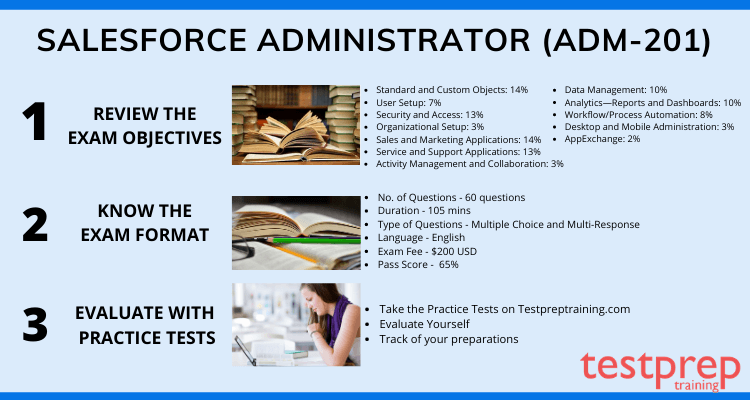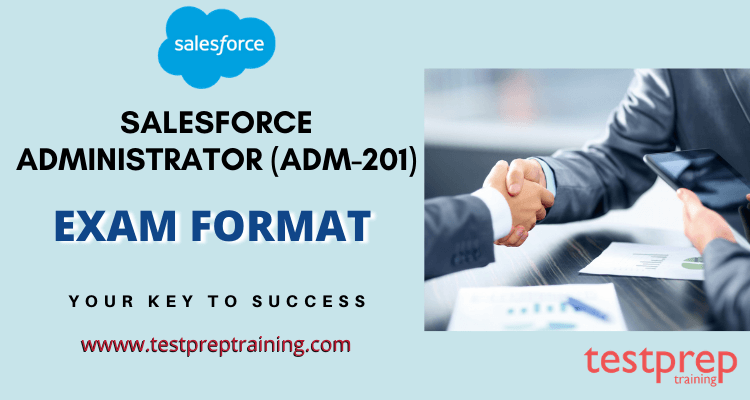The Salesforce Administrator (ADM-201) exam is an entry-level certification for individuals who are looking to establish their knowledge of Salesforce administration and development details. This form of certification is ideal for candidates that have ADM 212 experience, but anyone interested in the administration and development of cloud computing can take this exam to prove their knowledge and skills on the Salesforce platform.
The Salesforce Administrator (ADM-201) exam is designed to test your knowledge and skills as a Salesforce Administrator. The exam covers the following topics:
- Salesforce Fundamentals: This includes your knowledge of the Salesforce platform, its features, and its capabilities.
- Data Management: This covers how to manage data within Salesforce, including data import, export, and deduplication.
- Security and Access: This covers how to secure data in Salesforce and how to manage user access and permissions.
- Salesforce User Setup: This covers how to set up users in Salesforce and how to configure profiles, roles, and permission sets.
- Standard and Custom Objects: This covers how to create, modify, and delete standard and custom objects in Salesforce.
- Sales and Marketing Applications: This covers how to use Salesforce for sales and marketing, including lead management, campaign management, and opportunity management.
- Service and Support Applications: This covers how to use Salesforce for service and support, including case management, knowledge management, and service contracts.
Salesforce Administrator Exam Format
Understanding the exam format assists in devising an effective preparation and test-taking strategy. The Salesforce Administrator (ADM-201) exam comprises 60 multiple-choice questions and allows 105 minutes for completion. The questions follow a linear format, preventing you from revisiting previous ones once answered.
The ADM-201 exam covers a range of topics related to Salesforce administration, including data management, security and access, user setup, standard and custom objects, and sales and marketing applications. The exam aims to assess your understanding and proficiency in these areas, evaluating your capability to apply them practically.
Questions are scored according to difficulty, giving more weight to challenging ones. To pass the ADM-201 exam, you need a score of 65%, requiring correct answers to at least 39 out of the 60 questions.
The ADM-201 exam is delivered online through the Salesforce certification portal. You can take the exam from any location with a stable internet connection. During the exam, you are not allowed to use any study materials or reference guides, and you are not allowed to communicate with anyone else. If you need any assistance during the exam, you can use the online chat function to contact the exam proctor.
Additionally, there’s no penalty for incorrect answers, allowing you to make educated guesses when necessary. Lastly, the exam fee for the Salesforce Administrator Exam is $200, and applicable taxes must be paid in accordance with local laws.
Salesforce Administrator (ADM-201) Course Outline
The salesforce Administrator exam objectives are as follows –
Configuration and Setup: 20%
- Describe the information found in the company settings (for example: company settings fiscal year, business hours, currency management, default settings).
- Distinguish and understand the administration of declarative configuration of the User Interface. (for example: UI settings, app menu, list views, global actions, Lightning App Builder).
- Given a scenario, demonstrate the proper setup and maintenance of users.
- Explain the various organization Security Controls. (for example: Setup Audit Trail, Login Hours, Session Settings)
- Given a user request scenario, apply the appropriate security controls based on the features and capabilities of the Salesforce sharing model. (for example: public groups, org wide default, sharing: roles, subordinates, hierarchy, report and dashboard folders)
- Given a scenario, determine the appropriate use of a custom profile or permission set using the various profile settings and permissions.
Object Manager and Lightning App Builder: 20%
- Describe the standard object architecture and relationship model. (for example: standard object, parent/child, master detail/lookup/junction relationships, and record types.)
- Explain how to create, delete, and customize fields and page layouts on standard and custom objects, and know the implications of deleting fields.
- Given a scenario, determine how to create and assign page layouts, record types and business processes for custom and standard objects.
Sales and Marketing Applications: 12%
- Given a scenario, identify the capabilities and implications of the sales process. (for example: sales process, opportunity, path, and forecast impact.)
- Given a scenario, apply the appropriate sales productivity features using opportunity tools. (for example: dashboards, lead scoring, Einstein opportunity scoring, and home page assistant.)
- Describe the capabilities of lead automation tools and campaign management. (for example: leads, lead convert, lead assignment rules, campaign and campaign members.)
Service and Support Applications: 11%
- Describe the capabilities of case management. (for example: case, case assignment rules, and queues.)
- Given a scenario, identify how to automate case management. (for example: support process, case auto-response rules, and case escalation.)
Productivity and Collaboration: 7%
- Describe the capabilities of activity management.
- Describe the features of Chatter.
- Describe the capabilities of Salesforce Mobile App.
- Identify use cases for AppExchange applications.
Data and Analytics Management: 14%
- Describe the considerations when importing, updating, transferring, mass deleting, exporting and backing up data.
- Describe the capabilities and implications of data validation tools.
- Describe the options available when creating or customizing a report or report type.
- Describe the impact of the sharing model on reports.
- Describe the options available when creating and modifying dashboards (e.g., dashboard components, data sources, chart types, Subscribing, running user).
Workflow/Process Automation: 16%
- Given a scenario, identify the appropriate automation solution based on the capabilities of the tool.
- Describe capabilities and use cases for Flow.
- Describe capabilities and use cases for the approval process.
Prepare with Salesforce Administrator Study Guide
Here are some key areas that a study guide for the Salesforce Administrator (ADM-201) Exam should cover:
- User Management: Creating and managing users, setting up user profiles, roles, and permissions.
- Data Management: Importing data, managing data quality, creating custom objects and fields, and working with standard objects like accounts, contacts, and leads.
- Security and Access: Understanding the security model, sharing settings, and data visibility.
- Customization: Creating custom tabs, page layouts, and custom applications, using custom formula fields, validation rules, and custom workflows.
- Reporting and Analytics: Creating and managing reports and dashboards, and understanding the analytics query language (SOQL).
- Workflow and Approvals: Setting up automated workflows, process builder, and approvals, and automating tasks with triggers.
- Mobile Configuration: Setting up mobile app access, and customizing the mobile experience.

With such countless websites offering assets on the internet, there is a high possibility of falling into unauthentic resources. Hence, you should pick the right and most true resources to prepare yourself for the Salesforce Administrator Exam. The most ideal approach to do this is by visiting the official site of Salesforce. This is the page where you will get all the readings, training, and courses.
You can also take Instructor-led training courses. These are a great way to add new knowledge and skills to your repertoire. They offer the flexibility to either complete courses in your own time through our e-learning platform or attend a live course with an instructor. Learn new skills, improve existing ones, or develop new leadership skills.
Further, you should get familiar with the trailhead site. For any Salesforce credential, the trailhead is the place where you will get the documentation, Tip Sheets, and User Guides.
If you wish to get a better understanding of all the topics in the most flexible way, we recommend you to take our online course. This is a package of video lectures that cover all the domains of this exam in detail. Also, you get access to this course for a lifetime. The contents of the course get updated regularly to meet the latest trend and standards. Thus, you can be assured of quality and relevance.
Exam Tips:
Here are some tips to help you prepare for the Salesforce Administrator (ADM-201) Exam:
- Familiarize yourself with the Salesforce platform: Get hands-on experience by practicing on a trial org or sign up for a free developer account.
- Study the Official Study Guide: The study guide provided by Salesforce is a great resource and covers all the topics included in the exam.
- Take online courses: Numerous online courses offer comprehensive coverage of the exam’s tested topics.
- Use practice exams: Make use of the online practice exams to assess your understanding and pinpoint areas for improvement.
- Join study groups: Participate in online study groups and discuss exam topics with other Salesforce professionals.
- Read the Salesforce Help & Training materials: This is an all-encompassing resource that addresses every aspect of the Salesforce platform.
- Stay up-to-date with Salesforce releases: Stay informed about new features and enhancements to the platform by regularly reading the Salesforce Release Notes.
Expert Corner
The Salesforce Administrator Certification will certainly help you explore new career options. But to earn it, you’ll have to clear a tough examination. With the above-mentioned steps, it will be easier for you to comprehend the exam format and course outline. Further, you can prepare with the official resources. The last step will be to get yourself acquainted with the exam pattern and the experience of solving the actual test questions. For this, we recommend you take multiple practice tests. You can try a free practice test here to check where you stand with your current level of knowledge!



